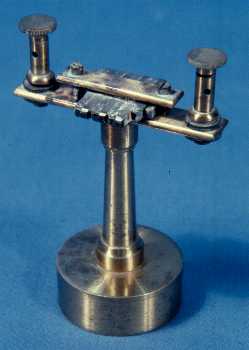Differential Thermopile
When a loop circuit is made of two dissimilar metals,
and the two junctions between the two wires are held at different temperatures,
an EMF is produced and a current can be detected with a sensitive galvanometer.
This is the Seebeck
Effect, discovered by Thomas Seebeck in 1821. The effect is multiplied
when there are a number of junctions in series in the circuit, with alternate
junctions in close thermal contact with each other. The use of the root
pile mirrors the arrangement of galvanic pairs in a galvanic
pile.
| The Differential Thermopile was invented by Macedonio
Melloni (1798-1854), an Italian physicist who worked in France and Italy.
Melloni's research dealt with thermal radiation, and he developed the
thermopile to make quantitative measurements of the intensity of the radiation.
The construction can be seen in the two examples below,
with the metals being bismuth and antimony. The instrument at the right
is by James W. Queen & Co. of Philadelphia; it was the top of the line
model with 49 pairs of junctions, and cost $40.00 in the 1881 catalogue.
|
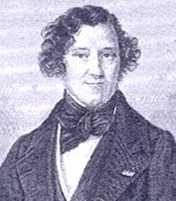
|
St. Mary's College
Kenyon College
The instrument is called a Differential Thermopile,
which means that it is able to compare the thermal radiation of two different
sources. The two examples below have horns pointing toward each of the
two sources. The Transylvania instrument is by Elliott Brothers of London,
and the one at Colby College is by Queen.
Transylvania University
Colby College
The thermopile at Union College was made by L.E. Knott of
Boston, and cost about $15.00. The Washington and Jefferson and Washington
and Lee differential thermopiles are by E.S. Ritchie. The model with 20
pairs of junctions sold for $25.00 in the 1881 catalogue; for $40.00 you
could get the 49 pair model. With an end-cap covering one set of thermo-junctions,
the differential thermopile could be used to study, for example, the reflection
of thermal radiation or the inverse-square law.
Union College
Washington and Jefferson College
Washington and Lee University
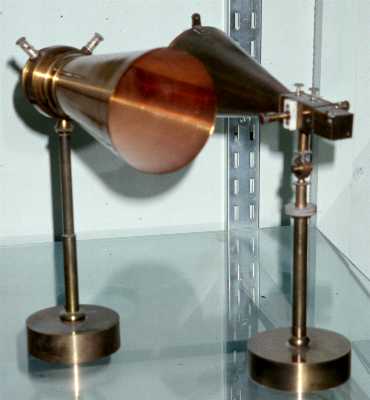
|
At the left are two thermopiles in
the Garland Collection of Classical Physics Apparatus at Vanderbilt University.
The right-hand apparatus is marked "Ateliers Ruhmkorff / J. Carpentier /
Ingr Constr / Paris. It was probably acquired about 1875.
The thermopile in the right-hand picture is in the collection
at Dartmouth College, where it is described as a Line Thermo-
pile. The aperture is clearly long and narrow, enabling it to be
used with infra-red radiation emanating from a slit. The other side of
the thermo-junction is held at room temperature inside the brass case.
There is no maker's mark, but it looks like the Rhumkorff apparatus in
the left-hand picture.
|
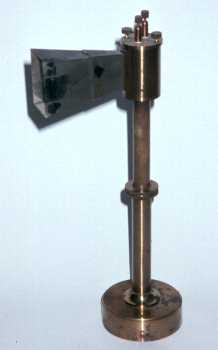
|
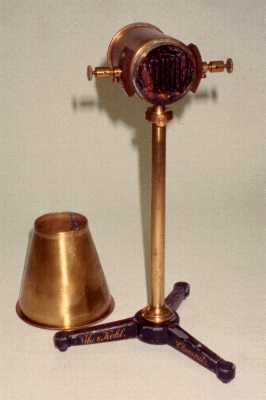
|
The Differential Thermoscope at the left was made
by Max Kohl of Chemnitz, German. It has only one horn; the reference
junctions on the opposite side face a sheet of brass at room temperature.
The cost of this device depended on the number of junctions.
In the Kohl catalogue ca. 1900:
24 junctions -- 44 Marks
36 junctions -- 66 Marks
48 junctions -- 83 Marks
60 junctions -- 100 Marks
(with the German Mark at about 25 cents)
This apparatus is in the Millington/Barnard Collection
of the University of Mississippi.
|
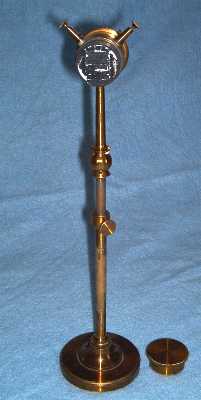
|
The copper-constantan thermopile at the right was made
by the Eppley Laboratory, a company best known for making Standard
Cells for use with potentiometers.
It is in the Greenslade Collection, and I would estimate that it dates
from about 1930.
At the left is a tall (32 cm hight) differential thermopile
whose elements are set into plaster of paris. It is unmarked, but came
to the Greenslade Collection from Kirov in Russia.
|
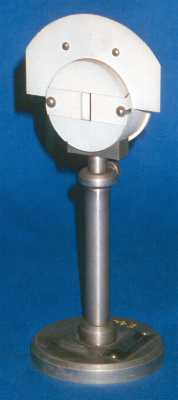
|
This unmarked differential thermopile
is in the apparatus collection at Holbart and William Smith Colleges in Geneva,
New York.
|

|
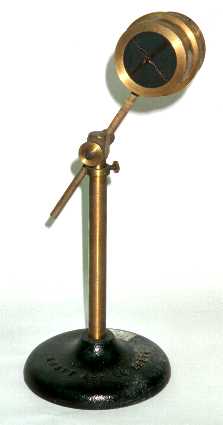
|
The instrument at the left is listed in the 1916 Knott catalogue
as "An Improved Mineralite Thermopile." This appears to be a Bismuth-Antimony
thermopile with up to 120 pairs of junctions. The cost of the more sensitive
of the two instruments in the catalogue was $14.50.
The catalogue gives data showing how the instrument was considerably
more sensitive mthat a 20-pair thermopile in detecting the radiation from
the sun on a "typical Boston Winter's day."
The apparatus is in the collection of Westminster College
in New Wilmington, Pennsylvania.
|
Return
to Heat Home Page | Return
to Home Page
